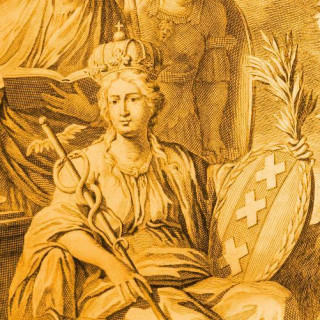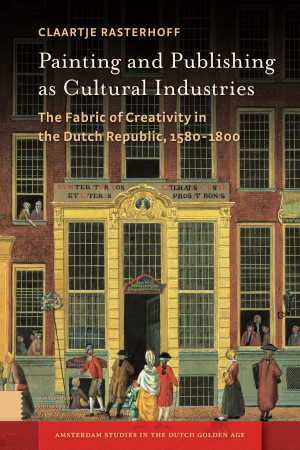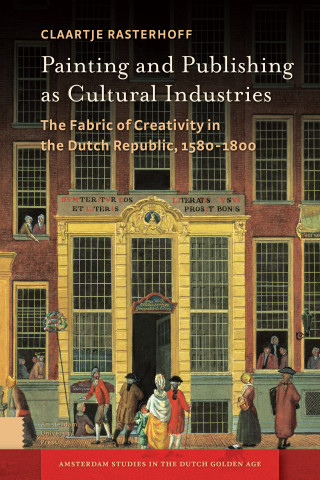

- Titel
- Painting and Publishing as Cultural Industries
- Subtitel
- The Fabric of Creativity in the Dutch Republic, 1580-1800
- Auteur
- Claartje Rasterhoff
- ISBN
- 9789048524112
- Uitvoering
- eBook PDF
- Aantal pagina's
- 352
- Taal
- Engels
- Publicatiedatum
- 15 - 11 - 2016
- Afmetingen
- 15.6 x 23.4 cm
- Open access
- Download op Open Access Platform
- Partner

- Categorie
- Early Modern Studies
- Voorbeeld
- Download introductie
- Ook beschikbaar als
- Hardback - € 165,00
This book is structured according to economic sector and chronological development (8 chapters).
1 Introduction
1.1 Cultural production in the Golden Age
1.2 Cultural industries
1.3 Spatial clusters
1.4 Datasets
1.5 Outline of the book
2 Window of opportunity, 1580-1610
2.1 Introduction
2.2 The Dutch Revolt, an external shock
2.3 New publishers, new markets
2.4 New markets, new products
2.5 The organisation of the trade
2.6 Conclusion
3 Unlocking potential in the book industry, 1610-1660
3.1 Introduction
3.2 Democratisation of demand
3.3 Paper, type and copy
3.4 Local specialization
3.5 Financial administration
3.6 Guild regulations and auctions
3.7 Censorship and privileges
3.8 Competition
3.9 Conclusion
4 Publishers in search of new markets, 1660-1800
4.1 Introduction
4.2 Domestic demand
4.3 Internationalisation
4.4 Related and supporting industries
4.5 Partnerships, mergers, and financial tricks
4.6 Guilds, from production to trade
4.7 Skills and routines
4.8 Competition
4.9 Conclusion
PART 2: PAINTING
5 A period of transition, 1580-1610
5.1 Introduction
5.2 Expansion of the art market
5.3 Spatial clustering and the impact of immigration
5.4 Measuring artistic prominence
5.5 Styles and genres
5.6 Conclusion
6 A new growth dynamic, 1610-1650
6.1 Introduction
6.2 Golden Age painting
6.3 From artistic novelties to product and process innovations
6.4 Competition: quantity and quality
6.5 Specialisation and product variants
6.6 Geography of production
6.7 Local schools of painting?
6.8 Market organisation
6.9 Conclusion
7 Transformation of the art market, 1650-1800
7.1 Introduction
7.2 Artistic decline and the art-historical bias
7.3 Substitute forms of interior decoration
7.4 Internationalisation and a lively second hand market
7.5 Quality uncertainty and creative (re)production
7.6 Occupational and social differentiation
7.7 Academies
7.8 Geography
7.9 Conclusion
8 Conclusion
8.1 Summary of the research
8.2 Early modern Dutch cultural industries
8.3 Industrial life cycles of early modern Dutch cultural industries
8.4 Spatial clustering as an explanatory framework
8.5 Dutch cultural industries from an international perspective
Summary in Dutch
Acknowledgements
Primary sources
Selected Bibliography
Recensies en Artikelen
"[In this book] there is a great deal to admire, and [it] will be required reading for any future students of the Dutch Golden Age." - Andrew Pettegree, University of St Andrews, English Historical Review Volume 133, Issue 565 (December 2018)
"This is a remarkable work of integration and synthesis of scholarship that advances a fresh understanding and illustrates novel analytical tools at work in an area of study exceptionally rich." - Sandra van Ginhoven, BMGN - Low Countries Historical Review. 132. (2017).
Claartje Rasterhoff
Painting and Publishing as Cultural Industries
The Fabric of Creativity in the Dutch Republic, 1580-1800
De onderstaande tekst is niet beschikbaar in het Nederlands en wordt in het Engels weergegeven.
The Dutch Republic was a cultural powerhouse in the modern era, producing lasting masterpieces in painting and publishing, and in the process transforming those fields from modest trades to booming industries. This book asks the question of how such a small nation could become such a major player in those fields. Claartje Rasterhoff shows how industrial organisations played a role in shaping patterns of growth and innovations. As early modern Dutch cultural industries were concentrated geographically, highly networked, and institutionally embedded, they were able to reduce uncertainty in the marketplace and stimulate the commercial and creative potential of painters and publishers-though those successes eventually came up against the limits of a saturated domestic market and an aversion to risk on the part of producers that ultimately brought an end to the boom.
Auteur
Claartje Rasterhoff
Claartje Rasterhoff studied history at the University of Amsterdam and Utrecht University. She currently works as a post-doctoral researcher and lecturer in Arts and Culture Studies at Erasmus University Rotterdam.




